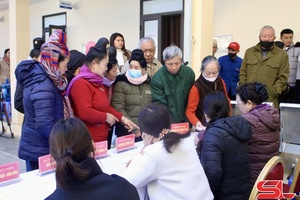
Brocade products by women’s union members in Gia Phu commune
Learning to weave from childhood, Lo Thi Khuong in Buc sub-zone has spent over 40 years mastering the craft. What began as weaving for household use gradually grew into a commercial endeavour, producing traditional brocades. Beyond creating her own products, Khuong also buys pieces from local women and turns them into items such as cushions, blankets, pillows, and double mattresses, which are sold to customers both within and outside the province.

Brocade fabric products displayed at Phu Yen commune’s New Rice Festival
The Khao Hamlet Traditional Cotton Weaving Cooperative in Tuong Ha commune currently provides jobs for more than 30 local labourers, producing brocade items such as shirts, handbags, scarves, pillows, and seat cushions. Recently, members received digital transformation training through the IDAP subproject, part of GREAT 2, funded by the Australian government, which focuses on training, consulting, digital adoption, skill enhancement, and market connection for ethnic minority women. After the training, members learned to build social media pages, price products, use artificial intelligence for promotional content, and connect with customers through digital platforms, helping expand their market reach and boost sales.
.png)
A visitor experiences weaving at Phu Yen’s Xip Xi Tet Festival.
To preserve and promote traditional weaving, local authorities have stepped up awareness campaigns, encouraging communities to actively safeguard the craft. Surveys identify families capable of passing on their skills, opening their homes to visitors for hands-on experiences, collaborative production, and the creation of unique, eye-catching souvenirs. Supported by funding from various programmes and projects, many localities organise craft workshops led by skilled artisans and experienced weavers, while also exhibiting and promoting brocade products at cultural events to connect with potential buyers.
By sustaining traditional weaving, these communities continue to develop and diversify distinctive handicrafts, enhance promotion efforts, attract tourists for experiences and shopping, generate income, create jobs, and make a positive contribution to local socio-economic development.






(1).jpg)
















You have 500/500 characters left
Please enter 5 or more characters!!!